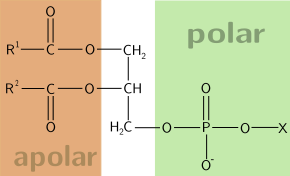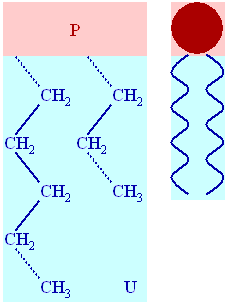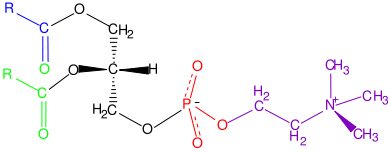Phospholipid
Please Take Over This Page and Apply to be Editor-In-Chief for this topic: There can be one or more than one Editor-In-Chief. You may also apply to be an Associate Editor-In-Chief of one of the subtopics below. Please mail us [1] to indicate your interest in serving either as an Editor-In-Chief of the entire topic or as an Associate Editor-In-Chief for a subtopic. Please be sure to attach your CV and or biographical sketch.
Overview


The U indicates the uncharged hydrophobic portion of the molecule, highlighted in blue.

Phospholipids are a class of lipids, and a major component of all biological membranes, along with glycolipids, cholesterol and proteins. Understanding of the aggregation properties of these molecules is known as lipid polymorphism and forms part of current academic research.
Amphipathic character
Due to its polar nature, the head of a phospholipid is hydrophilic (attracted to water); the lipophilic (or often known as hydrophobic) tails are not attracted to water. When placed in water, phospholipids form one of a number of lipid phases. In biological systems this is restricted to bilayers, in which the lipophilic tails line up against one another, forming a membrane with hydrophilic heads on both sides facing the water. This allows it to form liposomes spontaneously, or small lipid vesicles, which can then be used to transport materials into living organisms and study diffusion rates into or out of a cell membrane.
This membrane is partially permeable, capable of elastic movement, and has fluid properties, in which embedded proteins (integral or peripheral proteins) and phospholipid molecules are able to move laterally. Such movement can be described by the Fluid Mosaic Model, that describes the membrane as a mosaic of lipid molecules that act as a solvent for all the substances and proteins within it, so proteins and lipid molecules are then free to diffuse laterally through the lipid matrix and migrate over the membrane. Cholesterol contributes to membrane fluidity by hindering the packing together of phospholipids. However, this model has now been superseded, as through the study of lipid polymorphism it is now known that the behaviour of lipids under physiological (and other) conditions is not simple.
See also
- Alkylphosphocholines
- Antiphospholipid syndrome
- Biochemistry
- Lipid
- Lipid bilayer (e.g., Cell membrane)
- Polymorphism (biophysics)
References
- J.M.Berg, J.L. Tymoczko, and L. Stryer, Biochemistry. 5th ed. 2002, New York: W.H. Freeman. xxxviii, 974, [976] (various pages)
Template:Membrane lipids
Template:Phospholipids
{{Phosphate biochemistry}}
bg:Фосфолипид ca:Fosfolípid cs:Fosfolipid da:Fosfolipid de:Phospholipide et:Fosfolipiidid ko:인지질 hr:Fosfolipidi id:Fosfolipid is:Fosfólípið it:Fosfolipide he:פוספוליפיד lb:Phospholipid lt:Fosfolipidai mk:Фосфолипид nl:Fosfolipide sl:Fosfolipid fi:Fosfolipidi sv:Fosfolipid th:ฟอสโฟลิพิด